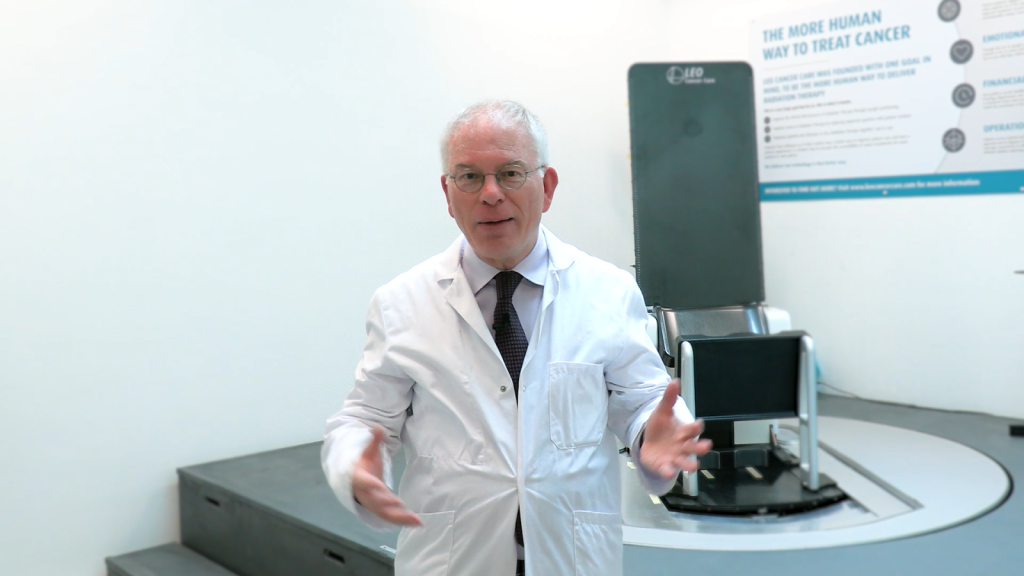An interview featuring Professor Vincent Gregoire, Head of Radiation Oncology at Centre Léon Bérard and a founding member of the Upright Photon Alliance
In this interview, we speak with Vincent Gregoire from Centre Léon Bérard, the first clinical site to receive one of Leo Cancer Care’s upright patient positioning system and founding member of the Upright Photon Alliance, to discuss his reasons for joining the Alliance and what research he is excited to explore next.
What is your background in radiation therapy?
I got my medical degree in Belgium, I then started my training as a Radiation Oncologist and moved to Amsterdam for a fellowship. I spent 2 years in Houston, Texas working at the MD Anderson Cancer Center before returning to Belgium in the mid-1990s to develop my career at St Luc University Hospital in Brussels. I rapidly devoted my time to head and neck radiation oncology and subsequently became the radiation oncology lead for it. In May 2018 I moved from Brussels to Lyon to lead the radiation oncology department at Centre Léon Bérard.
I made this move to Lyon for several reasons; Firstly, Lyon is the third largest cancer center in France. We treat a little less than 4000 patients a year in the field of radiation. In total, about 20 or 30,000 patients a year are treated at Centre Léon Bérard.
Secondly, I was close to 55 year old when I was approached regarding this role and I thought it might be a good idea for the last part of my professional career, to move and to take on another challenge. Centre Léon Bérard didn’t need me for treating patients, they already did it very well, I joined to provide a more academic and translational research direction to the team.
When did you first hear about upright radiotherapy. And what were your first thoughts about it when you heard of it?
When I moved to Lyon, one of my initial projects was to build a proton therapy facility. I talked to several people, including Rock Mackie (Co-founder of Leo Cancer Care), who I knew through my involvement with ICRU, the International Commission of Radiation Unit and Measurements. He told me
“Vincent, that’s interesting because you may want to consider not only having a rotating gantry for your proton facility, but also having a fixed beam and a rotating chair. I need to introduce you to the CEO of Leo Cancer Care”
Stephen Towe was the man I needed to speak with, I was introduced and the discussions went well.
We first discussed the seat in front of a proton therapy beam and then a photon horizontal beam. I recognized that this would be a new challenge and a new thing to consider in the field of radiation, not only from the physiologic point of view, but also from the research and the cost point of view.
Here at Centre Léon Berard, we were the first academic center to publish data on patient immobilization upright in pelvic tumors with the work of Sophie Boisbouvier, our Research Radiation Therapist. We are also part of the international UPLIFT project, meaning we will have two PhD students, Sophie Boisbouvier being one and another joining us in September. We will also soon have a Fellow from Australia staying for 2-3 months as part of a project they are developing in Australia in conjunction with a proton therapy facility.
Where do you think upright radiotherapy will make the most impact?
We are building data that will allow me to answer that question. Firstly, what I can tell you so far from the pelvic tumor experience is that patients, especially elderly patients have more facility or at least they prefer to be seated compared to being laid down in a supine position. We will discover in the coming months whether it will be the same for the thoracic and head and neck, it’s likely so.
Secondly, from the physiological and organ position point of view, there are differences between supine and upright which might be going in the right direction in terms of dose distribution. Some research has shown that because of the different positioning of the bladder, when you treat cervical or prostate cancer, you may be able to spare more dose to the non-target volume, such as the small intestine. In the head and neck what I’m expecting, is that the posterior pharyngeal wall will be less irradiated when in an upright compared to supine position. This might have important consequences for swallowing function. In lung it’s obvious that the lung volume and the density of the lung will be different in upright compared to supine and the cranial caudal movement of the lung might be reduced.
Thirdly, the space required might be slightly smaller for an upright positioning and applied irradiation system. So will require a smaller bunker, a smaller bunker means less building investment and a reduction in cost for photons. For protons or heavy ions, undoubtedly there will be a huge cost reduction because the room will be much smaller compared to a rotating gantry room.
What was the main reason for Centre Léon Bérard to become part of the Upright Photon Alliance?
We are the number three cancer center in France and we are an academic cancer center. So, there was no discussion for me, we need to have a strong R&D component in the activities of our department. What else could we dream of than to collaborate with Leo Cancer Care to establish a strong R&D program in the field of upright position? This was an easy move, in my view, in favor of testing, and validating the use of upright system in the field of radiation oncology.
What qualities and values does Centre Léon Bérard as an institution have that will support its work within the alliance?
The first goal of my radiation oncology department is to provide the best care to patients. To treat patients with the utmost quality and to increase the quality of service that we deliver to patients. So both academic and clinical quality were good arguments to move into this business of collaborating with Leo Cancer Care and being one of the first user of this new challenging system.
Is there any other area that you are excited about exploring a little bit more?
The beauty of the collaboration and the research that we are conducting is not only to look at the variability and accuracy of patient positioning, but also explore the way we interact with patients. When a patient is supine we look down at them from above and there is a hierarchy to that with us as the boss. In an upright positioning system we are face-to-face with direct eye contact. This may make patients feel totally differently when they are on an even level with their care providers. From the Radiation Therapist’s point of view, it will probably need some readjustment on the way they interact with patients. It’s thus also an interesting program from the sociological point of view, the way we interact with the doctors makes a difference in the overall feeling of the patient care.
Please note: The Leo Cancer Care Upright Photon Solutions are not commercially available and are for research purposes only.
Subscribe to our newsletter
STAY CONNECTED
Get the latest updates and exclusive offers delivered straight to your inbox
Subscribe